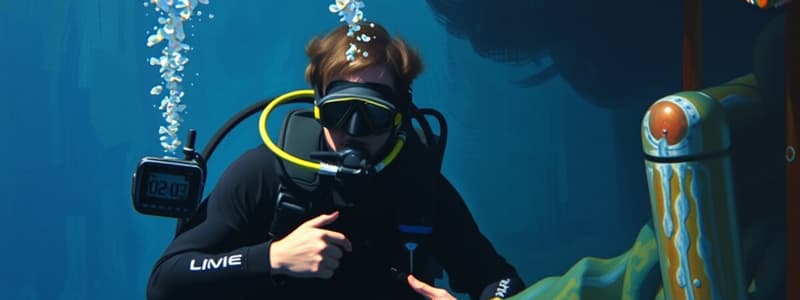Podcast
Questions and Answers
What does a good diving buddy do?
What does a good diving buddy do?
Makes diving more fun, is familiar with their buddy's diving equipment, and is able to help in all phases of diving and dive planning.
What does a dive computer help a diver to keep track of?
What does a dive computer help a diver to keep track of?
Nitrogen absorption levels.
What should you do if you lose contact with your buddy?
What should you do if you lose contact with your buddy?
Search for no more than a minute by turning 360 degrees and looking up and down, then perform a normal ascent to the surface.
What should dive buddy teams do when entering the water through the surf?
What should dive buddy teams do when entering the water through the surf?
What is the most important reason for planning your dives?
What is the most important reason for planning your dives?
What steps should be taken when selecting a dive site?
What steps should be taken when selecting a dive site?
You should perform a safety stop at 15 ft for 3-5 mins on every dive.
You should perform a safety stop at 15 ft for 3-5 mins on every dive.
How is the No-decompression Limit defined?
How is the No-decompression Limit defined?
What is the surface interval in diving?
What is the surface interval in diving?
How are rip currents formed?
How are rip currents formed?
Why is the use of the SSI Total Dive Log important?
Why is the use of the SSI Total Dive Log important?
What is residual nitrogen?
What is residual nitrogen?
How do you use a compass to navigate to a sighted object?
How do you use a compass to navigate to a sighted object?
Is it okay to share a computer with your dive buddy?
Is it okay to share a computer with your dive buddy?
What is the recommended maximum ascent rate?
What is the recommended maximum ascent rate?
Why are dive computers essential for planning and executing dives?
Why are dive computers essential for planning and executing dives?
Flashcards are hidden until you start studying
Study Notes
Diving Safety and Buddy System
- A good diving buddy enhances the experience, is familiar with each other's gear, and assists in all aspects of diving.
- Maintaining physical contact and timing entry during surf is crucial for buddy teams.
Dive Planning
- Planning dives prevents accidents; it's essential to execute dives according to plan.
- When selecting a dive site, consider the purpose, difficulty, personal skills, and those of your buddy.
Dive Equipment and Techniques
- A dive computer tracks nitrogen absorption, helping divers stay within no-decompression limits.
- Use a compass for navigation by aligning it with the target object and adjusting as needed.
- Sharing a dive computer with a buddy is not permitted.
Safety Procedures
- In case of losing contact with a buddy, search for one minute, looking around before ascending normally.
- Perform a safety stop at 15 feet for 3-5 minutes on every dive to enhance safety.
Diving Physiology
- The No-decompression Limit is the maximum time allowed at a depth without needing a mandatory stop during ascent.
- Surface interval refers to the time spent out of the water between diving sessions.
- Residual nitrogen is the excess nitrogen remaining in the bloodstream and tissues post-dive, which affects subsequent dives.
Environmental Awareness
- Rip currents are created when water retreats through channels in sandbars and reefs after breaking waves.
Documentation
- The SSI Total Dive Log is vital for recording medical history, emergency info, and personal dive records, serving as a resource for future dives.
Ascent Guidelines
- The recommended maximum ascent rate to ensure safety is 30 feet per minute.
- Dive computers are crucial tools for logging information, monitoring dives, and assisting in safe ascent/descent practices.
Studying That Suits You
Use AI to generate personalized quizzes and flashcards to suit your learning preferences.




